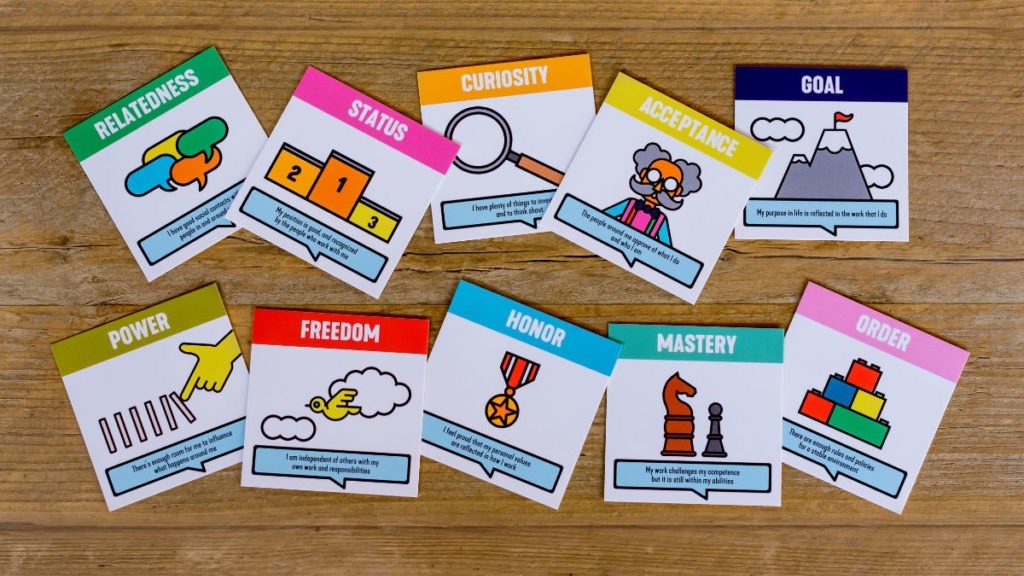
Management 3.0 Moving Motivators
Share

Management 3.0 Moving Motivators
What truly drives people to stand out?
Management 3.0 Moving Motivators is a Management 3.0 tool inspired by Daniel Pink’s concepts of autonomy, mastery, and purpose, as well as Herzberg’s motivation theory. It helps individuals and teams discover the intrinsic and extrinsic factors that influence their performance and satisfaction.
What is Moving Motivators?
Moving Motivators consists of 10 cards representing key motivators, including:
-
Acceptance: The feeling of belonging and being valued.
-
Curiosity: The desire to explore and learn new things.
-
Freedom: The need for autonomy and self-direction.
-
Honor: The importance of living by personal values.
-
Power: The ability to influence decisions and outcomes.
Each participant ranks these motivators from most to least important, creating a personal motivation map. The exercise is especially useful for exploring how workplace changes impact motivation.
How to Use Moving Motivators
Individual Use
-
Give each person a set of the 10 motivator cards.
-
Ask them to rank the cards in order of importance to their personal and professional life.
-
Discuss the ranking to gain insights into their main motivators and challenges.
-
If applicable, simulate changes in the work environment (e.g., a new project or team dynamic) and ask how that might affect their motivators.

Team Use with Radar Charts
When used with a team, Moving Motivators can reveal shared priorities and differences:
-
Data Collection
-
Each team member ranks their motivators individually.
-
Record their rankings for each motivator (e.g., on a 1–10 scale).
-
-
Create a Radar Chart
-
Plot each motivator on a radar chart.
-
For each motivator, calculate the average ranking, the minimum ranking (lowest priority), and the maximum ranking (highest priority) among team members.
-


3. Analyze the Results
-
The radar chart provides a visual summary of the team’s overall motivational profile.
-
The average ranking shows where the team collectively values a motivator.
-
The min and max rankings highlight the diversity of priorities, helping to identify potential alignment or conflictwithin the team.
Why the Radar Chart is Useful
-
Team Alignment: Shows where motivators converge, helping to identify shared values that can unite the team.
-
Diverging Priorities: By highlighting differences, it opens up conversations about how to meet individual needs while maintaining team cohesion.
-
Change Impact: When organizational changes are planned, the radar chart can help anticipate how motivation might shift.
-
Individual Coaching: I've used this tool in 1-on-1 meetings to uncover personal motivators and align tasks with what truly drives each person.
-
Team Radar Charts: By analyzing team motivators, we identified key areas of strong alignment (e.g., shared emphasis on freedom), and areas where differences could create friction (e.g., varied need for power).
For example, in one team, curiosity consistently scored high, so we built more learning opportunities into our processes. Meanwhile, power showed a wide range, meaning decision-making autonomy mattered more to some than others — so we adjusted our delegation strategy accordingly.
Moving Motivators is more than a personal reflection tool — it's a strategic way to visualize team dynamics and motivation. By leveraging the radar chart, teams can boost alignment, address differences, and adapt more effectively to change.
Have you explored what truly motivates your team?
If not, give Moving Motivators a try and see the difference it makes!
👉 Check out my upcoming trainings!
Supplementary Reading
Producer: Ricardo Fernandes
Linkedin
View All Trainings
